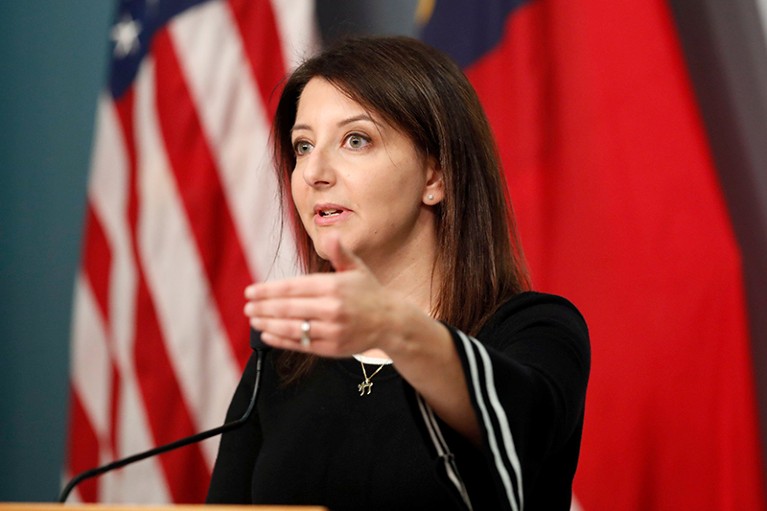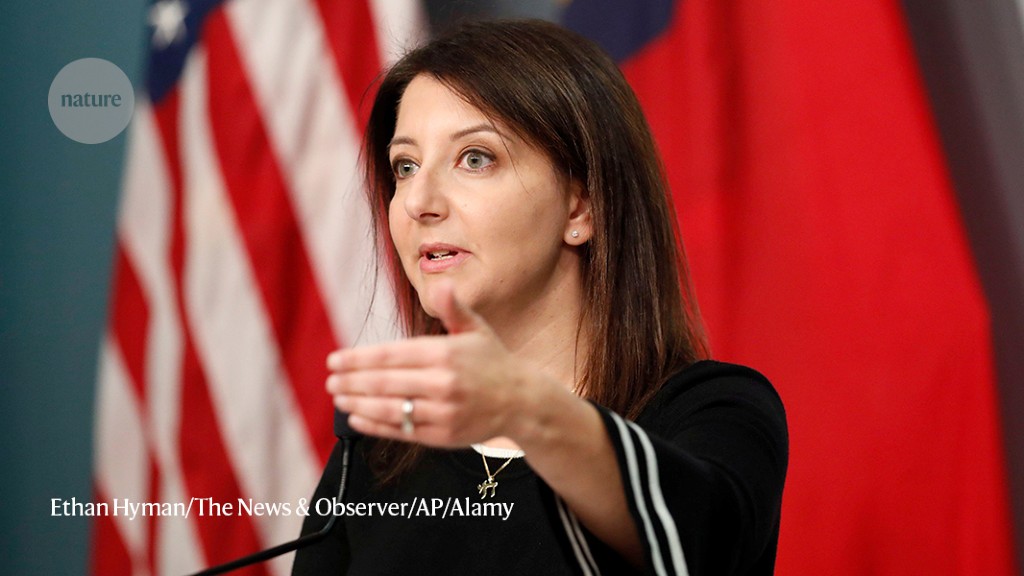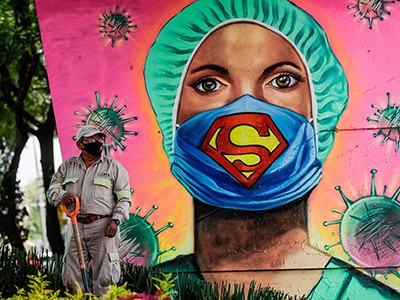
Mandy Cohen previously served as North Carolina’s health secretary.Credit: Ethan Hyman/The News & Observer/AP/Alamy
Once regarded as the gold standard for public-health agencies, the US Centers for Disease Control and Prevention (CDC) faces an unprecedented crisis, fuelled by chronic underfunding and anger about the agency’s response to the COVID-19 pandemic. But now the agency has a new leader to try to put things right: Mandy Cohen, a physician who served as North Carolina’s health secretary until the end of 2021, started her tenure as CDC director on Monday.
Cohen takes over the role previously filled by Rochelle Walensky, an infectious-disease specialist who left the CDC less than a year after announcing an initiative to overhaul the agency’s structure and operations. Among the challenges that Cohen inherits are restoring public and political support for the CDC, rebuilding the agency’s infrastructure, and improving its ability to make quick decisions in the face of emergencies. But public-health specialists say that Cohen’s experience at the state level have equipped her well to tackle the task.
“Dr Cohen spent several years working in North Carolina, having to do this tricky balance between what is the right thing to do from a purely scientific perspective, and how that can be implemented when you consider all of the challenges of public policy,” says Jay Varma, co-director of the Cornell Center for Pandemic Prevention and Response at Weill Cornell Medicine in New York City.
Heat from both sides
In Walensky’s last appearance before Congress, on 13 June, Republican members of the House of Representatives condemned the CDC’s guidance on masks, vaccines and school closures during the pandemic. But others take the opposing view, contending that the agency should have been more aggressive in its response to the emergency.
What the science says about lifting mask mandates
One of the priorities for the new director, Varma says, is to restore support for public health among politicians, community groups and citizens. “That means spending a lot of time with elected officials to help them understand how this work, on a day-to-day basis, is benefiting their constituents,” says Varma, who worked at the CDC for 20 years. Public health agencies, he says, “have not communicated strongly enough how they are very similar to fire departments and police departments, in that they keep people safe.”
Another priority should be modernizing the CDC’s data systems, which still rely on fax machines as the primary mover of information in some communities, says Georges Benjamin, the executive director of the American Public Health Association in Washington DC. “The CDC is always getting data way too late,” he says. “And that means we’re chasing very dangerous infectious diseases, and we’re behind the curve all the time.”
Staff shortages could also be a problem for Cohen. Varma notes that several mid-level and senior officials have left the CDC in the past few years because they felt that it didn’t provide a supportive work environment. “The new director will face a very big challenge in trying to recruit high-quality people to the CDC and, even more importantly, to retain them in the agency,” Varma says.
A call to action
Public-health experts say that the CDC needs to be more action-oriented and ready to make quick decisions based on the available science.
Over the past several decades, Varma says, the agency has become increasingly technocratic, focusing heavily on scientific and policy issues. “All of those are very important. But the challenge is that, when you focus on those issues, you lose some of the boots-on-the-ground expertise,” he says.
Benjamin notes that Walensky has already started to move the agency in that direction. “That’s a cultural change and those are tough to do. But Dr Cohen demonstrated that kind of attitude as a health commissioner in North Carolina, so we would anticipate she’ll bring that style to the CDC.”
Budget crunch
Implementing some of the necessary changes might be difficult with the agency’s current budget, however. According to a report published last month by Trust for America’s Health (TFAH), an advocacy group in Washington DC, the CDC’s budget rose by just 6%, after adjusting for inflation, over the past decade. That wasn’t enough to keep pace with emerging threats and the country’s growing public health needs, the report said. “Underfunding will continue to limit how modern and effective the CDC can be,” says Dara Lieberman, director of government relations at TFAH and one of the authors of the report.
The CDC also needs to have more flexibility in how it manages its resources, Lieberman says. “Congress has placed very strict limits on how things like emergency funding can be spent,” she says. When mpox emerged, for example, Congressional rules barred health departments from using their COVID response funding for mpox vaccination, even though the two emergencies were happening at the same time.
What does the future look like for monkeypox?
One area that has been especially underfunded, Lieberman adds, is chronic-disease prevention. “We’re spending over US$4 trillion a year on health-care costs, but only about 4–5% of that is spent on preventing disease,” she says. “Instead of paying so much to treat conditions once people have them, we could get a major return on investment if we tried to address the root causes of disease.”
Joshua Sharfstein, a vice-dean at the Johns Hopkins Bloomberg School of Public Health in Baltimore, Maryland, thinks that the CDC has already entered a rebuilding phase. In August 2022, Walensky launched the Moving Forward initiative, aiming to reorganize the agency. The CDC “is on the right track”, Sharfstein says, “and I think Dr Cohen will be a terrific leader to go even further”.









More News
How artificial intelligence is helping Ghana plan for a renewable energy future
Editorial Expression of Concern: Leptin stimulates fatty-acid oxidation by activating AMP-activated protein kinase – Nature
Quantum control of a cat qubit with bit-flip times exceeding ten seconds – Nature